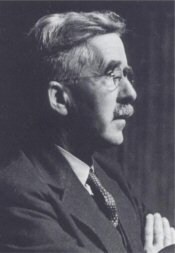| |
|

Arthur Mee was born into a working class family
in Stapleford in 1875. He was the second child and oldest son
of Henry Mee, a mechanical engineer, and his wife, Mary. The family
was a very happy one, and in time there were to be ten children
altogether. Both of Arthur’s parents were noted for their
piety, and his father was a deacon in the Baptist Chapel they
attended.
Arthur’s formal education lasted till he was 14 years old.
A friend later wrote that he left school,
... a sound English scholar, but too soon for
even a peep into classical realms. He had no aptitude for chemistry,
mechanics, or geometry, and as an editor he imagined that present-day
pupils might have been equally unattracted by these subjects.
Hence his disinclination to the use in his publications for
the young of technical terms common to most schoolboys of today.
Never would he use such words, for example, as “diameter”
or “circumference,” but always width, and so many
feet or yards round. If a technical term was not familiar to
him, he argued, then it might be unfamiliar to thousands of
others, both adult and juvenile. The practice had its disadvantages
in lack of precision and directness, but Arthur had ever in
mind the one who might not know and might be gravelled by technicalities.
(Ernest Bryant, quoted in Sir John Hammerton’s Child of
Wonder: An Intimate Biography of Arthur Mee, pp. 27-28)
In 1889 he commenced his first job, as a copy-holder for the
Nottingham Evening Post, and this proved to be the first step
to a career in journalism. He was an excellent journalist, and
before many years passed he was in London, first working for one
of the London newspapers, and then free-lancing.
Shortly after his move to London, Arthur Mee married Amy Fratson.
They had one daughter, born in 1901, who they named Marjorie.
Like other children, Marjorie was full of questions, and it was
this fact that led to the publication of The Children’s
Encyclopaedia. Her father later wrote about it as follows:
“...there came into her mind the great
wonder of the Earth. What does the world mean? And why am I
here? Where are all the people who have been and gone? Where
does the rose come from? Who holds the stars up there? What
is it that seems to talk to me when the world is dark and still?
So the questions would come, until the mother of our little
maid was more puzzled than the little maid herself. And as the
questions came, when the mother had thought and thought, and
answered this and answered that until she could answer no more,
she cried out for a book: ‘Oh for a book that will answer
all the questions!’ And this is the book she called for.”
(“To Boys and Girls Everywhere”, in volume 1 of
The Children’s Encyclopedia)
Arthur Mee’s books proved extremely popular with adults
and children alike. His biographer, Sir John Hammerton, comments
“Whatever one’s opinion may be of the merits of Arthur
Mee’s books as contributions to English literature—and
there is room for difference of opinion on that subject—no
one is likely to dispute their inspirational value to their own
age (p. 223f.). According to Hammerton, one of the reasons for
this popularity was that “[he] had the power to make plain
to the average man, woman, and child the aspects and imports of
the problems which the very men who had wrested them from nature
could not make so plain” (p. 158) – and this was done
in such a way as to communicate the writer’s own enthusiasm
for his topic to the reader. There are scientists and historians
today who credit Arthur Mee with introducing them to the subject
that later became their specialty. Others tell of how they taught
themselves to read with the aid of the Children’s Encyclopedia,
or how they read it from cover to cover, with obvious delight.
He was a prolific writer. Apart from The Children’s Encyclopedia
he produced a number of biographies, a Children’s Bible,
Children’s Shakespeare, books of travels around England
and Europe, and various anthologies of quotations from great men
and women of the past (his Book of Everlasting Things, for instance).
He also founded and edited the Children’s Newspaper, and
was dubbed “journalist in chief to British youth”.
Finally, it must be said that Arthur Mee was a man of his time.
He was known publicly as a Christian, and stood up boldly for Christian
principles, though at the same time he was a staunch believer in
evolution, and seems not to have believed in the literal resurrection
of the Lord Jesus. His view of evolution was like that of Charlotte
Mason (among others) – namely that evolution was a wonderful
discovery whereby people could now see, scientifically, exactly
how God had created the world. He had a great reverence for the
Bible and its teachings, and this comes across very clearly in what
he writes. His writings also reflect his intense patriotism and
his optimism that the world was getting better, and would continue
to do so for the rising generation. Arthur Mee died suddenly in
May 1943, following an operation.
Copyright © Ruth Marshall
2004 http://wonder.riverwillow.com.au
Further information on Arthur Mee's life and work may be found in:
Sir. John Alexander Hammerton, Child of Wonder: An intimate biography
of Arthur Mee, Hodder & Stoughton: London, 1946 [out of print]
Simon Appleyard, The Storytellers: A Glimpse into the Lives of 12
English Writers, First published in 1991 by This England Books,
73 Rodney Road, Cheltenham, Gloucestershire, ISBN 0 906324 20 3
[available from This England]
|

